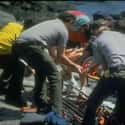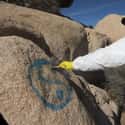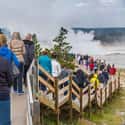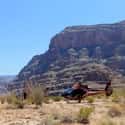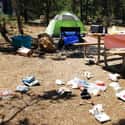-
(#5) People Underestimate Nature And Need To Be Rescued
Many emergency situations that happen in national parks are due to illness, such as heart attacks or heat stroke, but other times injuries or death occurs because people are careless. Emergency workers responded to 2,658 incidents in 2014 and had to spend between $4 to $5 million to help people who found themselves in trouble in national parks. Rescues are usually dangerous to the emergency workers as well, so keep that in mind when you're walking on slippery rocks next to a raging river.
In addition to ignoring warnings about animals and being attacked, hikers can become lost, fall off ledges when not paying attention (including into the Grand Canyon), or attempt physical feats they are not prepared for. Being safe should be obvious, but when people who've never rafted or backpacked before find themselves going over a waterfall or lost in a remote area with no map, people quickly realize how dangerous being unprepared can be.
-
(#7) Vandals Spray Graffiti And Destroy Landmarks
One would think the natural beauty of the national parks would be art enough, but there have been many cases of graffiti since the parks have been open, with artists often posting photos of their works to their social media accounts.
Gallery curator and graffiti supporter Jeremy Cross noted:
In the modern art climate, throwing graffiti up on a downtown wall is passé. Tagging a national park ups the ante. Of course, you're setting yourself up for a public stigma — and not a good one.
Casey Nocket (aka creepytings) who left her work in seven national parks has been banned for life. Her work included acrylic paint which is extremely difficult to remove without damaging rocks. Cleanup also isn't cheap and if the graffiti is too close to artifacts like petroglyphs, there is risk of even more damage to remove it. Some people ditch the paint and actually destroy natural monuments, like a group of teens in Oregon.
-
(#3) Crowds Are Congesting Trails And Trampling The Paths
More visitors to a park means more people out on the trails. While everyone deserves a chance to see the amazing vistas and plant life, too many people hiking at once can sometimes ruin the experience. And since not all people appreciate nature in the same way, not everyone is going to have a good time. Despite having to deal with park visitors taking selfies in front of every other tree or complaining about the lack of cell service, the trails themselves are hurting from all those feet.
"We're concerned about impacts on resources, vegetation, soils... and impacts to wildlife that frequent those areas," Mary Riddle of Glacier National Park commented. In addition to trails being overcrowded, there is danger to the environment if visitors go off the trail or park their cars in non-designated areas. However, it is true that the national parks were created in order for people to visit, walk around, and be enjoyed. As one park lover said, "What do we do, stop people from coming?"
-
(#12) Sightseeing Planes And Helicopters Create Air And Noise Pollution From Above
Several companies have set up business close to national parks, offering sightseeing tours via airplane or helicopter. They offer the ability to see amazing sights, such as the Grand Canyon, from a different viewpoint and without bumping shoulders with other visitors. While tours from above do help cut down on the amount of vehicles and selfie-takers throughout the national parks, traffic from above can also cause noise pollution and may slowly make noise in these preserved areas more comparable to urban areas.
However Dan Haynes who runs a helicopter tour organization above Great Smoky Mountains National Park points out:
As for the impact of air tours over the parks, I believe [they have] the least negative impact [on] the environment – but the worst perceived impact by those enjoying the parks from the ground...They leave no footprints, no trash and offer many people a fantastic view...In short, we are not around long and we leave no trace.
If you're traveling to Yosemite, leave your drones at home. They are banned from the park for causing noise pollution affecting both visitors and animals, and may impede with emergency rescue operations.
-
(#6) Tourists Leave Their Trash On Trails And In Campsites
A 2010 report estimated that Acadia National Park in Maine spent $120,000 to remove trash from the park. Volunteers at Great Smoky Mountains National Park spent 3,410 hours picking up after visitors. Clearly, the people that travel to national parks across the country each year leave a lot of junk behind and removing this waste requires a lot of money and time. Keeping parks clean is an important part of preserving their beauty and many parks have taken extra measures to save their attraction, such as recycling programs and encouraging the use of refillable bottles.
Litter in national parks not only ruins the landscape but can also be hazardous to animals if they ingest the trash. Tim Jarell, head of maintenance at the Grand Canyon notes, "Deer have starved to death because of their stomachs being full of trash and condors have been x-rayed with coins and other trash in their stomachs."
-
(#10) Tourists Can Spread Disease And Introduce Invasive Species To Parks
Quagga and zebra mussels have slowly made their way across the United States thanks to hitching rides on boats and being transported to other bodies of water by fishermen and boaters. Most water vehicles, including those without motors like canoes and kayaks, must be cleaned and inspected before they're allowed into national parks. These rules are put in place to protect the ecosystem of each park, as outside animals, plants, and insects can cause harm.
Unfortunately, it isn't always easy. Visitors can carry invasive seeds into parks via their clothing, cars, or pets. Sometimes seeds are stuck in mud attached to wheels or boots. Many parks also restrict visitors from bringing their own firewood since it may be carrying invasive insects like gypsy moths or diseases such as Emerald ash borer.
New Random Displays Display All By Ranking
About This Tool
In recent years, the number of tourists to American national parks has surged. However, incidents of tourists failing to comply with the rules and being injured by animals have also increased significantly, causing concerns among management agencies and environmental protection organizations. Many tourists approach wild animals without authorization, causing their own casualties, or injuring animals. For example, a Canadian tourist once drove away a small bison, causing the bison herd to no longer accept the small bison, and the staff had to euthanize the small bison.
More tourist violations have increased the workload of the park staff and are gradually destroying the ecological environment of the national parks. In some extreme cases, tourists even died. You could find 15 descriptions of terrible tourist behaviors with the generator.
Our data comes from Ranker, If you want to participate in the ranking of items displayed on this page, please click here.











